Titanium Metal
Titanium was discovered in Cornwall, England, by William Gregor in 1791 and named by Martin Heinrich Klaproth for the Titans of Greek mythology. The element occurs within a number of mineral deposits, principally rutile and ilmenite, which are widely distributed in the Earth’s crust and lithosphere, and it is found in almost all living things, rocks, water bodies, and soils.The metal is extracted from its principal mineral ores via the Kroll process or the Hunter process.
Its most common compound, titanium dioxide, is a popular photocatalyst and is used in the manufacture of white pigments. Other compounds include titanium tetrachloride (TiCl4), a component of smoke screens and catalysts and titanium trichloride (TiCl3), which is used as a catalyst in the production of polypropylene.
Titanium Wedding Ring
A metallic element, titanium is recognized for its high strength-to-weight ratio. It is a strong metal with low density that is quite ductile (especially in an oxygen-free environment), lustrous, and metallic-white in color. The relatively high melting point (more than 1,650 °C or 3,000 °F) makes it useful as a refractory metal. It is paramagnetic and has fairly low electrical and thermal conductivity.
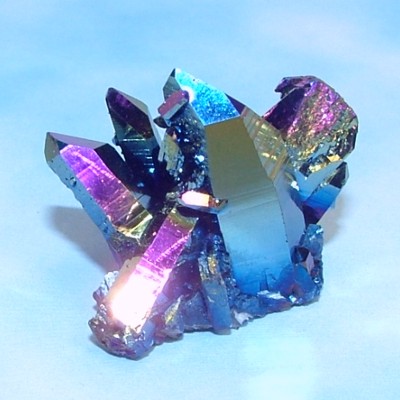 Titanium Crystal
Titanium Crystal
Commercial (99.2% pure) grades of titanium have ultimate tensile strength of about 63,000 psi (434 MPa), equal to that of common, low-grade steel alloys, but are 45% lighter. Titanium is 60% more dense than aluminium, but more than twice as strong as the most commonly used 6061-T6 aluminium alloy. Certain titanium alloys (e.g., Beta C) achieve tensile strengths of over 200,000 psi (1,400 MPa).However, titanium loses strength when heated above 430 °C (806 °F).
Titanium at A380 Engine
The processing of titanium metal occurs in 4 major steps :
- Reduction of titanium ore into “sponge” , making a porous form
- Melting of sponge or sponge plus a master alloy to form an ingot
- Primary fabrication, where an ingot is converted into general mill products such as billet, bar, plate, sheet, strip, and tube
- Secondary fabrication of finished shapes from mill products.
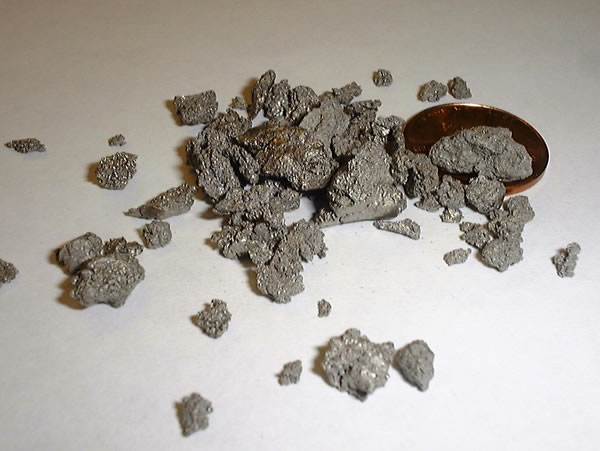 Titanium Sponge
Titanium Sponge
Because the metal reacts with oxygen at high temperatures it cannot be produced by reduction of its dioxide. Titanium metal is therefore produced commercially by the Kroll process, a complex and expensive batch process. (The relatively high market value of titanium is mainly due to its processing, which sacrifices another expensive metal, magnesium.In the Kroll process, the oxide is first converted to chloride through carbochlorination, whereby chlorine gas is passed over red-hot rutile or ilmenite in the presence of carbon to make TiCl4. This is condensed and purified by fractional distillation and then reduced with 800 °C molten magnesium in an argon atmosphere.
Titanium Dioxide
A more recently developed method, the FFC Cambridge process, may eventually replace the Kroll process. This method uses titanium dioxide powder (which is a refined form of rutile) as feedstock to make the end product which is either a powder or sponge. If mixed oxide powders are used, the product is an alloy manufactured at a much lower cost than the conventional multi-step melting process. The FFC Cambridge process may render titanium a less rare and expensive material for the aerospace industry and the luxury goods market, and could be seen in many products currently manufactured using aluminium and specialist grades of steel.
The Pourbaix diagram for titanium in pure water, perchloric acid or sodium hydroxide
Common titanium alloys are made by reduction. For example, cuprotitanium (rutile with copper added is reduced), ferrocarbon titanium (ilmenite reduced with coke in an electric furnace), and manganotitanium (rutile with manganese or manganese oxides) are reduced.
2 FeTiO3 + 7 Cl2 + 6 C — 2 TiCl4 + 2 FeCl3 + 6 CO (900 °C)
TiCl4 + 2 Mg — 2 MgCl2 + Ti (1100 °C)
Common titanium alloys are made by reduction. For example, cuprotitanium (rutile with copper added is reduced), ferrocarbon titanium (ilmenite reduced with coke in an electric furnace), and manganotitanium (rutile with manganese or manganese oxides) are reduced.
Titanium Ring
Titanium alloys are metallic materials which contain a mixture of titanium and other chemical elements. Such alloys have very high tensile strength and toughness (even at extreme temperatures), light weight, extraordinary corrosion resistance, and ability to withstand extreme temperatures.
Application of Titanium Alloys
However, the high cost of both raw materials and processing limit their use to military applications, aircraft, spacecraft, medical devices, connecting rods on expensive sports cars and some premium sports equipment and consumer electronics. Auto manufacturers Porsche and Ferrari also use titanium alloys in engine components due to its durable properties in these high stress engine environments.
 Phase Diagram Ti-V
Phase Diagram Ti-V
The crystal structure of titanium at ambient temperature and pressure is close-packed hexagonal alpha phase with a c/a ratio of 1.587. At about 890°C, the titanium undergoes an allotropic transformation to a body-centred cubic beta phase which remains stable to the melting temperature. Some alloying elements raise the alpha-to-beta transition temperature (i.e. alpha stabilizers) while others lower the transition temperature (i.e. beta stabilizers). Aluminium, gallium, germanium, carbon, oxygen and nitrogen are alpha stabilizers. Molybdenum, vanadium, tantalum, niobium, manganese, iron, chromium, cobalt, nickel, copper and silicon are beta stabilizers.
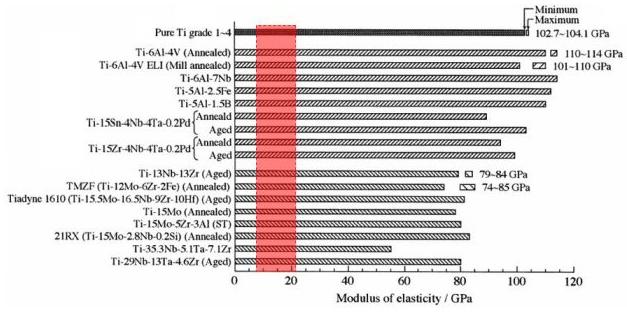 Table Titanium Grade - Modulus Elasticity
Table Titanium Grade - Modulus Elasticity
Titanium Alloys are generally classified into four main categories:
- Commercially Pure Alloys. There are five grades of what is known as commercially pure or unalloyed titanium, ASTM Grades 1 through 4, and 7. Each grade has a different amount of impurity content, with Grade 1 being the most pure. Tensile strengths vary from 172 MPa for Grade 1 to 483 MPa for Grade 4.
- Alpha alloys which contain neutral alloying elements (such as tin) and/ or alpha stabilisers (such as aluminium or oxygen) only. These are not heat treatable. Titanium alpha alloys are alloys that typically contain aluminum and tin, though they can also contain molybdenum, zirconium, nitrogen, vanadium, columbium, tantalum, and silicon. Alpha alloys do not generally respond to heat treatment, but they are weldable and are commonly used for cryogenic applications, airplane parts, and chemical processing equipment.
- Near-alpha alloys contain small amount of ductile beta-phase. Besides alpha-phase stabilisers, near-alpha alloys are alloyed with 1-2% of beta phase stabilizers such as molybdenum, silicon or vanadium.
- Alpha & Beta Alloys, which are metastable and generally include some combination of both alpha and beta stabilisers, and which can be heat treated. Alpha-beta alloys can be strengthened by heat treatment and aging, and therefore can undergo manufacturing while the material is still ductile, then undergo heat treatment to strengthen the material, which is a big advantage. The alloys are used in aircraft and aircraft turbine parts, chemical processing equipment, marine hardware, and prosthetic devices.
- Beta Alloys, which are metastable and which contain sufficient beta stabilisers (such as molybdenum, silicon and vanadium) to allow them to maintain the beta phase when quenched, and which can also be solution treated and aged to improve strength. The smallest group of titanium alloys, beta alloys have good hardenability, good cold formability when they are solution-treated, and high strength when they are aged. Beta alloys are slightly more dense than other titanium alloys, having densities ranging from 4840 to 5060 kg/m3. They are the least creep resistant alloys, they are weldable, and can have yield strengths up to 1345 MPa. They are used for heavier duty purposes on aircraft.
Phase Diagram Titanium - Aluminum
Generally, beta-phase titanium is stronger yet less ductile and alpha-phase titanium is more ductile. Alpha-beta-phase titanium has a mechanical property which is in between both. Titanium dioxide dissolves in the metal at high temperatures, and its formation is very energetic. These two factors mean that all titanium except the most carefully purified has a significant amount of dissolved oxygen, and so may be considered a Ti-O alloy. Oxide precipitates offer some strength (as discussed above), but are not very responsive to heat treatment and can substantially decrease the alloy’s toughness.
Phase Diagram Titanium - Fe
Many alloys also contain titanium as a minor additive, but since alloys are usually categorized according to which element forms the majority of the material, these are not usually considered to be “titanium alloys” as such. See the sub-article on titanium applications.
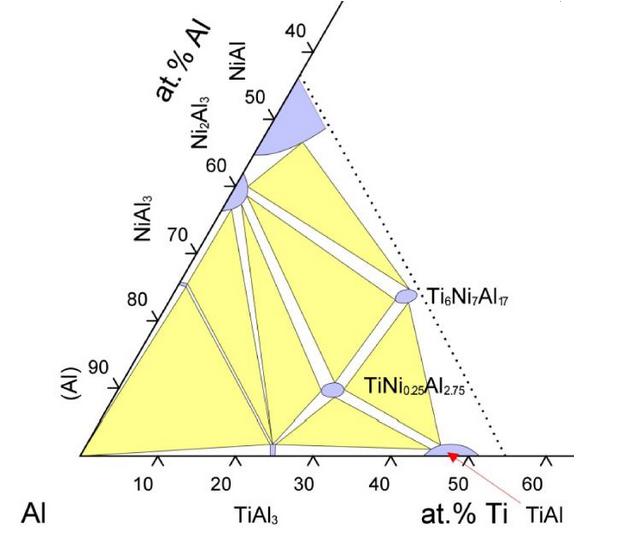 Phase Diagram Ti-Ni-Al
Phase Diagram Ti-Ni-Al
Titanium alone is a strong, light metal. It is as strong as steel, but 45% lighter. It is also twice as strong as aluminium but only 60% heavier. Titanium is not easily corroded by sea water, and thus is used in propeller shafts, rigging and other parts of boats that are exposed to sea water. Titanium and its alloys are used in airplanes, missiles and rockets where strength, low weight and resistance to high temperatures are important. Further, since titanium does not react within the human body, it and its alloys are used to create artificial hips, pins for setting bones, and for other biological implants.
The ASTM defines a number of alloy standards with a numbering scheme for easy reference.
- Grade 1-4 are unalloyed and considered commercially pure or “CP”. Generally the tensile and yield strength goes up with grade number for these “pure” grades. The difference in their physical properties is primarily due to the quantity of interstitial elements. They are used for corrosion resistance applications where cost and ease of fabrication and welding are important.
- Grade 5, also known as Ti6Al4V, Ti-6Al-4V or Ti 6-4, is the most commonly used alloy. It has a chemical composition of 6% aluminium, 4% vanadium, 0.25% (maximum) iron, 0.2% (maximum) oxygen, and the remainder titanium. Grade 5 is used extensively in Aerospace, Medical, Marine, and Chemical Processing. It is used for connecting rods in ICEs. It is significantly stronger than commercially pure titanium while having the same stiffness and thermal properties (excluding thermal conductivity, which is about 60% lower in Grade 5 Ti than in CP Ti). Among its many advantages, it is heat treatable. This grade is an excellent combination of strength, corrosion resistance, weld and fabricability. In consequence, its uses are numerous such as for military aircraft or turbines. It is also used in surgical implants Generally, it is used in applications up to 400 degrees Celsius. Its properties are very similar to those of the 300 stainless steel series, especially 316. It has a density of roughly 4420 kg/m3, Young’s modulus of 110 GPa, and tensile strength of 1000 MPa. By comparison, annealed type 316 stainless steel has a density of 8000 kg/m3, modulus of 193 GPa, and tensile strength of only 570 MPa. And tempered 6061 aluminium alloy has 2700 kg/m3, 69 GPa, and 310 MPa, respectively.
- Grade 6 contains 5% aluminium and 2.5% tin. It is also known as Ti-5Al-2.5Sn. This alloy is used in airframes and jet engines due to its good weldability, stability and strength at elevated temperatures.
- Grade 7 contains 0.12 to 0.25% palladium. This grade is similar to Grade 2. The small quantity of palladium added gives it enhanced crevice corrosion resistance at low temperatures and high pH.
- Grade 7H contains 0.12 to 0.25% palladium. This grade has enhanced corrosion resistance.
- Grade 9 contains 3.0% aluminium and 2.5% vanadium. This grade is a compromise between the ease of welding and manufacturing of the “pure” grades and the high strength of Grade 5. It is commonly used in aircraft tubing for hydraulics and in athletic equipment.
- Grade 11 contains 0.12 to 0.25% palladium. This grade has enhanced corrosion resistance.
- Grade 12 contains 0.3% molybdenum and 0.8% nickel.
- Grades 13, 14, and 15 all contain 0.5% nickel and 0.05% ruthenium.
- Grade 16 contains 0.04 to 0.08% palladium. This grade has enhanced corrosion resistance.
- Grade 16H contains 0.04 to 0.08% palladium.
- Grade 17 contains 0.04 to 0.08% palladium. This grade has enhanced corrosion resistance.
- Grade 18 contains 3% aluminium, 2.5% vanadium and 0.04 to 0.08% palladium. This grade is identical to Grade 9 in terms of mechanical characteristics. The added palladium gives it increased corrosion resistance.
- Grade 19 contains 3% aluminium, 8% vanadium, 6% chromium, 4% zirconium, and 4% molybdenum.
- Grade 20 contains 3% aluminium, 8% vanadium, 6% chromium, 4% zirconium, 4% molybdenum and 0.04% to 0.08% palladium.
- Grade 21 contains 15% molybdenum, 3% aluminium, 2.7% niobium, and 0.25% silicon.
- Grade 23 contains 6% aluminium, 4% vanadium, 0.13% (maximum) Oxygen. Improved ductility and fracture toughness with some reduction in strength.
- Grade 24 contains 6% aluminium, 4% vanadium and 0.04% to 0.08% palladium.
- Grade 25 contains 6% aluminium, 4% vanadium and 0.3% to 0.8% nickel and 0.04% to 0.08% palladium.
- Grades 26, 26H, and 27 all contain 0.08 to 0.14% ruthenium.
- Grade 28 contains 3% aluminium, 2.5% vanadium and 0.08 to 0.14% ruthenium.
- Grade 29 contains 6% aluminium, 4% vanadium and 0.08 to 0.14% ruthenium.
- Grades 30 and 31 contain 0.3% cobalt and 0.05% palladium.
- Grade 32 contains 5% aluminium, 1% tin, 1% zirconium, 1% vanadium, and 0.8% molybdenum.
- Grades 33 and 34 contain 0.4% nickel, 0.015% palladium, 0.025% ruthenium, and 0.15% chromium .
- Grade 35 contains 4.5% aluminium, 2% molybdenum, 1.6% vanadium, 0.5% iron, and 0.3% silicon.
- Grade 36 contains 45% niobium.
- Grade 37 contains 1.5% aluminium.
- Grade 38 contains 4% aluminium, 2.5% vanadium, and 1.5% iron. This grade was developed in the 1990s for use as an armor plating. The iron reduces the amount of Vanadium needed as a beta stabilizer. Its mechanical properties are very similar to Grade 5, but has good cold workability similar to grade 9.
You might also like
| Shape Memory Alloy "Animated lamp" designed by Romolo Stanco... | Hydrogen Embrittlement Hydrogen Embrittlement in carbon steel,... | What is Nanotechnology? Nanotechnology is the engineering method... | Whai is Stainless Steel? A Stainless Steel art deco sculpture... |
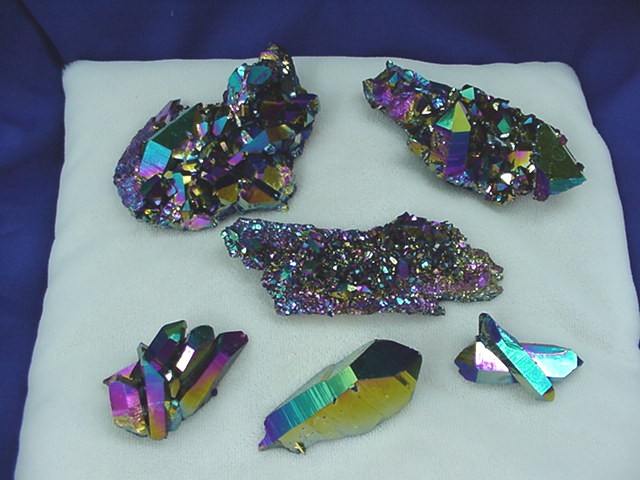
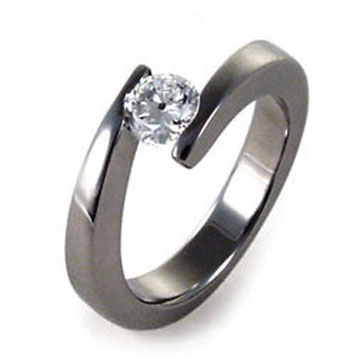

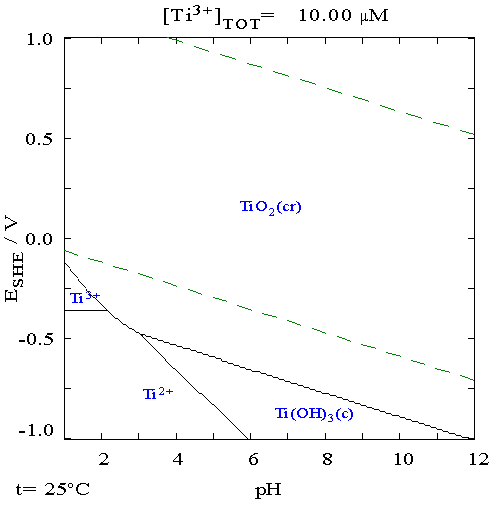
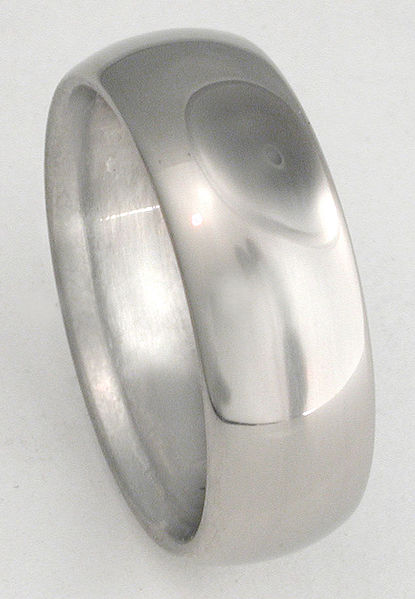

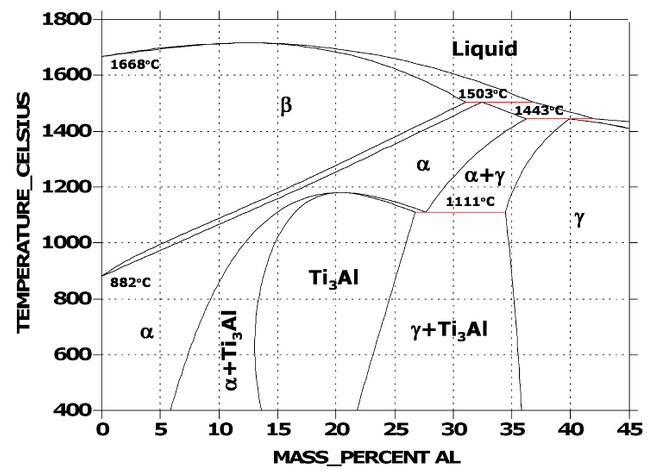
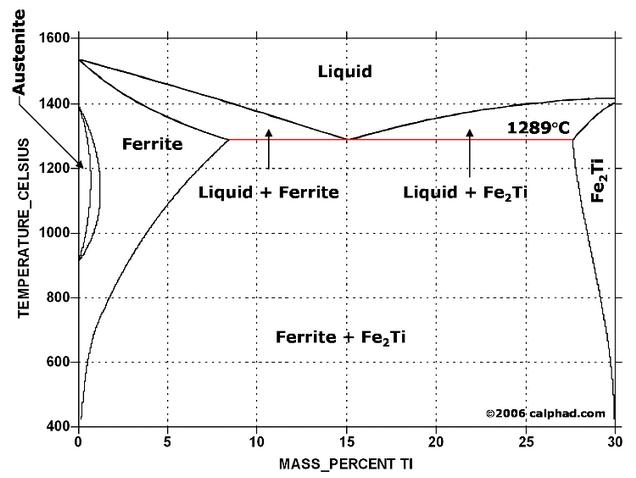
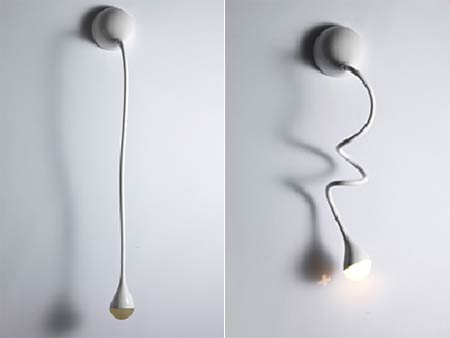
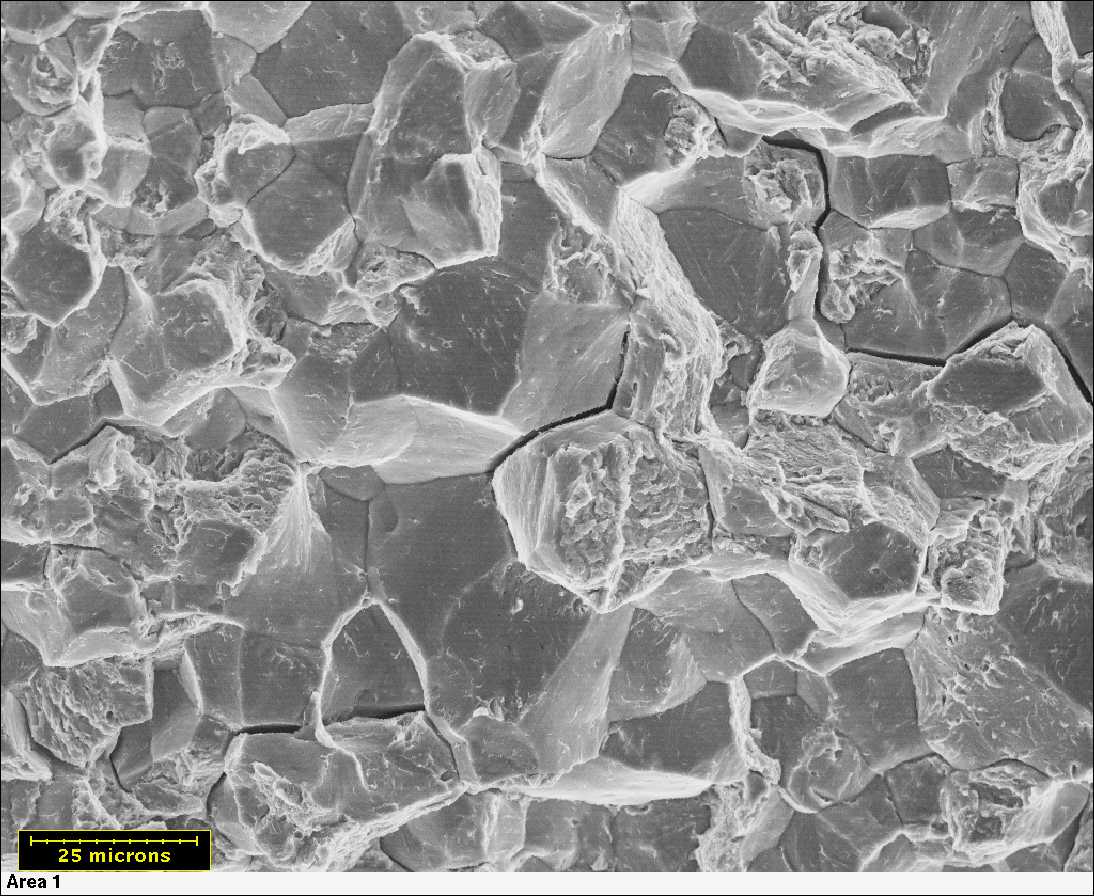

 Alloy Suppliers
Alloy Suppliers
 Aluminum
Aluminum
 Aluminum Extrusions
Aluminum Extrusions
 Copper-Brass-Bronze
Copper-Brass-Bronze
 Nickel
Nickel
 Magnets
Magnets
 Stainless Steel
Stainless Steel
 Stainless Steel Tubing
Stainless Steel Tubing
 Steel Service Centers
Steel Service Centers
 Titanium
Titanium
 Tungsten
Tungsten
 Wire Rope
Wire Rope